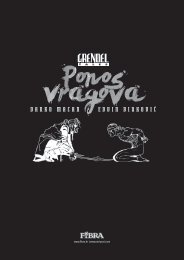Oscar Cahén
Art-Canada-Institute_Oscar-Cah%C3%A9n
Art-Canada-Institute_Oscar-Cah%C3%A9n
You also want an ePaper? Increase the reach of your titles
YUMPU automatically turns print PDFs into web optimized ePapers that Google loves.
<strong>Oscar</strong> <strong>Cahén</strong><br />
Life & Work by Jaleen Grove<br />
Making Fine Art<br />
In contrast to his illustration work, <strong>Cahén</strong> made sketches before embarking on a<br />
painting. He usually stuck to traditional media, such as oil on canvas or Masonite and<br />
watercolour, pastel, or ink on paper, though he sometimes painted with aniline dyes.<br />
Aniline dye is made from petroleum by-products and came in hues far more vibrant than<br />
any other art material of <strong>Cahén</strong>’s day—even neon pink. Unfortunately, many of these<br />
dyes have faded in his works.<br />
LEFT: <strong>Oscar</strong> <strong>Cahén</strong>, Still-life, 1950, pastel on illustration board, 71 x 91.3 cm, National Gallery of Canada, Ottawa RIGHT: <strong>Oscar</strong> <strong>Cahén</strong>, Untitled (427), c. 1952, reverse<br />
drawing from lithography stone, ink, and pastel, 71.1 x 50.8 cm, private collection<br />
Although he may have begun with sketches, <strong>Cahén</strong> built up his oil paintings in<br />
several passes on different days; he even went back into canvases he had formerly<br />
considered finished and had already signed—as we can tell by comparing the finished<br />
state of Untitled (221), 1953, how it appears in period photographs of the interior of<br />
<strong>Cahén</strong>’s home.<br />
<strong>Cahén</strong> apparently made few lithographs.<br />
He did, however, often ink up a stone, place<br />
paper on it lightly, and then rub it and draw on it<br />
with a sharp object. When the paper was lifted<br />
off, it picked up the ink and the stone’s<br />
pleasingly soft, dappled texture. The scored lines<br />
came out black. Drawing on the paper with the<br />
pointed tool left no visible mark, meaning <strong>Cahén</strong><br />
could not be exactly sure what he was doing.<br />
This exercise would have countered the slick<br />
facility that he was ever-wary of slipping into.<br />
<strong>Cahén</strong> experimented with ceramics,<br />
probably with Blue Mountain Pottery founders<br />
<strong>Oscar</strong> <strong>Cahén</strong>, plate, c. 1950–56, glazed<br />
terracotta, approx. 20 x 20 x 0.9 cm, The <strong>Cahén</strong><br />
Archives, Toronto<br />
<strong>Oscar</strong> <strong>Cahén</strong>, Untitled (1141), c. 1947–50, wood,<br />
approx. 15 x 17 x 12 cm, The <strong>Cahén</strong> Archives,<br />
Toronto<br />
63



